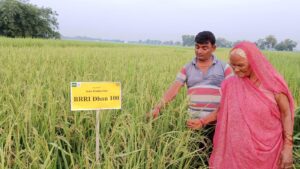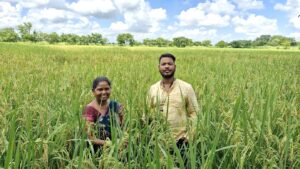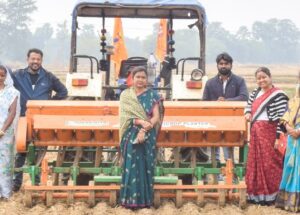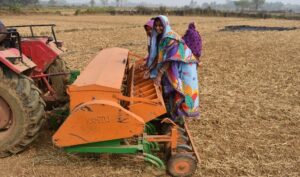
Five experts with wide-ranging knowledge—serving as the plenary speakers during the 4th International Rice Congress (IRC2014)—will be flagging cross-cutting issues for discussion among the attending rice scientists and industry players. All will be gathering in Bangkok during the last week of October. Their topics are critical to assuring that there will always be Rice for the World, the Congress’s overarching theme.
Enhancing the 6-day gathering throughout the week will be:
Ms. Marie Haga, executive director of the Global Crop Diversity Trust. She joined Global Crop Diversity Trust as executive director in March 2013.
Dr. Thomas Reardon, a professor in the Department of Agricultural, Food, and Resource Economics at Michigan State University. He has extensive research experience on food industry transformation, in particular the “supermarket revolution.
Mr. Vichai Sriprasert, honorary president of the Thai Rice Exporters Association and President and CEO of Riceland International Ltd. He is an expert on parboiling rice and was the first to introduce this processing technology from the United States to Thai rice mills in 1978.
Prof. John Colbourne from the School of Biosciences at The University of Birmingham. He regularly works with industry and advises government agencies and professional societies, aiming to transform practices at monitoring and protecting the environment.
Mr. Mark Lynas, environmental campaigner, journalist, and author. He has written several books on the environment, including High Tide, Six Degrees, and The God Species.
Agriculture—including rice— needs game changers
Ms. Haga will point out that, in the 1960s, agriculture flourished under the Green Revolution. Now, in light of climate change, she believes that agriculture needs a “Gene Revolution” to feed the world.
“Agriculture is probably facing its biggest challenge ever, and rice is not immune,” she says. “We need game changers in the way we do agriculture, The diversity contained within plant genetic resources provides a universe of untapped possibilities.”
“Crop diversity is the biological base of all agriculture,” she points out. “But as the diversity of rice is being lost through genetic erosion, supply of this staple grain becomes more vulnerable.”
In her presentation, Ms. Haga will explain why conservation of genetic resources of rice and other crops is critical to agriculture and the world’s future food supplies, particularly under rapidly changing climate patterns.
Transformation of Asia’s rice value chain
“There is a rapid transformation afoot in the rice value chain in Asia,” says Prof. Reardon. “The ‘upstream’ is changing quickly— farmers are undertaking capital-led intensification, and participating in burgeoning markets for land rental, fertilizer and pesticides, irrigation water, and seed. And at midstream, in wholesale and milling, there is a ‘quiet revolution’ underway, with thousands of entrepreneurs investing in equipment, increasing scale, and diversifying into higher quality.
“Farmers, with better access to improved varieties and technologies, are producing more rice with better quality and are moving beyond their village markets,” says Prof. Reardon. “Instead they are starting to sell their produce directly to mills and wholesale market traders for better prices. Meanwhile, millers and traders, especially in China, with the help of better technologies, have started selling branded, labeled bags to retailers.
“The transformation appears to be improving food security for cities, by reducing margins, offering lower consumer rice prices, and increasing quality and diversity of rice.” He bases this on extensive data from unique “stacked surveys” of all value chain segments, in seven zones, more or less developed, around Bangladesh, China, India, and Vietnam. He will flesh out the situation further during the IRC.
Why rice pricing and politics don’t mix
“Thailand had been the world’s largest rice exporter for decades,” says Mr. Sriprasert. “The country owed its success to the free trade policy initiated 150 years ago by King Rama IV.”
However, that all changed when the Pheu Thai Party made a key promise during the 2011 election to buy rice from local farmers at a generous price—about 50% above the market rates—to boost incomes for rural farmers. It backfired because rice traders promptly switched their purchases from Thailand to other rice suppliers, particularly India which lifted its four-year-old rice export restrictions in the same year and stabilized the rice market and prices.
“Farmers were not told that, at such high prices, not all the surplus crop could be exported,” he says. “Soon government warehouses bulged with an equivalence of two years unsold rice, and no cash to meet farmer obligations.”
Under the Rice Pledging Scheme, exports dropped to third place behind India and Vietnam. “The lesson: prices must not by the government,” says Mr. Sriprasert who will explain why it is best to let the markets play a decisive role in determining rice prices in his presentation.
Beyond the rice genome
The rice ecosystem isn’t just about the rice plants—it’s the whole landscape that includes a wealth of biodiversity, much of it beneficial to rice agriculture, but some rather harmful. For example, Prof. Colbourne asks what secrets lie in the genome of the water flea? “They could be the key to fighting invisible health threas such as chemical pollutants,” he exclaims!
“The genomes of agricultural and ecologically relevant species can reveal how animals respond to chemical threats that are found in our water supply,” he explains. “The goal is to measure the changes that happen in their genes that would then lead to technologies that may be able to tell us about the presence and effects of those chemical pollutants.”
Rapid technological improvements to access this “memory” encoded within genomes of populations promises to transform how the health of the environment is monitored and protected.
In his presentation, Prof. Colbourne will clarify how the application of 21st century technologies towards environment and health protection can promote not only public well-being, but also the economy, job creation, and global competitiveness of industrial, agricultural, and service sectors.
Where’s my GM rice?
Finally, Mr. Lynas, will point out that it’s high time to discuss genetically modified crops using scientific facts instead of muddling the issue with baseless fear tactics. He believes that ignoring scientific evidence about genetically modified crop safety and benefits is a threat to food security and the health of hundreds of millions of people.
“Rice remains locked out of the two-decade-old biotechnology revolution,” he says. “Largely because of political activism motivated by superstition and anti-science attitudes, there is up to now no GM rice available to consumers anywhere in the world.”
Mr. Lynas hasn’t always been a supporter of biotechnology. “In 2008, I was still penning diatribes in The Guardian [a UK broadsheet] attacking the science of GMThe Guardian [a UK broadsheet] attacking the science of GM,” he admits.
He will discuss why he is now critical of organizations that ignore scientific facts about the safety and the benefits of genetically modified crops such as Golden Rice. “If the industry self-imposed de facto moratorium on genetically improved rice is allowed to become a permanent fixture, the options for plant breeders will be constrained, and humanity will be denied the use of a major tool to feed the world more sustainably.” he says.









